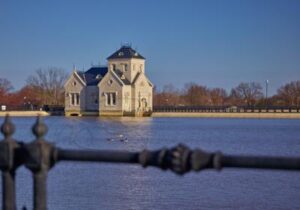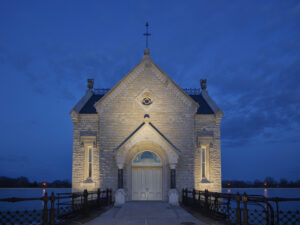 By Jay Ferguson, Louisville Water Museum Specialist
By Jay Ferguson, Louisville Water Museum Specialist
The Crescent Hill Reservoir was added to the National Register of Historic Places in 1979. Donna C. Hopkins, the Deputy State Historic Preservation Officer, nominated the reservoir, listing engineering, architecture, and social history as its areas of significance.
The application included the reservoir, the gatehouse, the “Superintendent’s House” (now known as the Shelter House), and “Reservoir Park.” The gatehouse was singled out as the focal point of the reservoir complex. Its architectural design was noted as “a fine example of the High Victorian Gothic style of which few exist in the Falls of the Ohio region.”
Hopkins described both the gatehouse and Shelter House as solid-looking buildings with blocky proportions and deeply recessed windows, along with heavy stone details, window surrounds, and hoodmolds.
Even though Chief Engineer Charles Hermany is named as the designer, Hopkins proposed the theory that Harry P. McDonald, a civil engineer employed by Louisville Water from 1873 through 1876, may have been involved. Upon McDonald’s departure he worked as an architect — at times with his brothers — until his death in 1904.
Some of the buildings that McDonald’s firm designed were the Kansas State Capital in Topeka and several churches both here in Louisville and in New Orleans.
For nearly 130 years, Louisville Water has maintained the architectural integrity and, with some changes, the original essence of the Crescent Hill Reservoir. In 2013, the gatehouse was completely renovated inside and out. The Shelter House, built in the 1880s as restroom facilities for the park’s visitors (many of them arriving by train) has sat nearly vacant for years, except for some equipment stored in the basement area.
Beyond the property’s architectural significance, the application stated that “the beautiful grounds were a popular gathering point for early east end inhabitants.” Hopkins described the sides of the reservoir as “grassy and well maintained, giving the appearance of a neat, sloping lawn.”
She also noted that “atop the embankments, around the perimeter, is a grand promenade of flagstones. Further defining the crests of the embankment is a lively, continuous cast-iron railing.” And she noted that the reservoir was “a focal point of the Crescent Hill neighborhood.”
It still is. Many neighbors come to the reservoir to use its grounds for jogging, strolling, and biking. It’s still “an integral part of the neighborhood as well as being an architectural masterpiece.”


